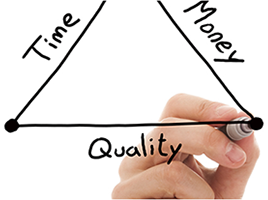If you search for ERP implementation tragedies, it isn’t hard to find examples. There are lots of scary statistics on ERP failure rates too. It’s enough to make you shy away from making the move to a new ERP system.
The good news is that ERP implementation doesn’t have to turn tragic. If you look at ERP successes, you’ll recognize the common denominator – a solid strategy.

How to Develop a Strong ERP Project Strategy
Implementing an ERP system is a major undertaking. You have to realize it isn’t easy and it takes much time and effort to create a well-thought-out strategy. But in the end, your reward will be your own ERP implementation success story and tangible benefits for your business and employees.
Let’s see some positive statistics and benefits that modern ERP solutions provide.
From the Aberdeen Group:
- ERP reduces operational costs by 23%
- ERP reduces administrative costs by 22%
- ERP increases on-time deliveries by 24%
From Panorama Consulting:
- The top 3 benefits gained from ERP software are:
- Reduced process time
- Increased collaboration
- Centralized enterprise data
Step 1: Vision and Discovery
Assemble a Discovery Team
Here’s where you begin the process to see what makes sense for an ERP system. First, assemble a Discovery team. It should consist of senior stakeholders, technical leads, and someone from each department. If you will be using a consultant(s), include them too.
Define the Vision
The Discovery Team should set out to visualize where they would like the business to be in the future, projecting out 5 to 10 years. They should think big and focus on success, keeping in mind the company’s goals and how they can be attained.
The team should take a good look at the present state of the company and what it will take to achieve its vision. Understanding where the organization is currently, and where they would like it to be, will help them to discover how an ERP system can get the business there.
Information Gathering/Identifying Pain Points
The Discovery Team will need to look at the organization’s current systems and processes to understand what problems exist and what pain points need to be solved. There may be a lack of quality control, difficulties with tracking production costs, too much inventory on hand, or all of these and more. It’s important to take each issue identified and list them in order of priority.
The Discovery Team should also determine what successful implementation would be like, what functionality is needed, and whether the ERP system should be on-premise or cloud-based.
Step 2: Analysis
Determine the Business Case
This step takes the information from the Discovery phase to put together a business case. The business case describes the project objectives and how the ERP system solves them. It will include the following:
- Benefits – What gains will the company achieve with ERP software?
- Risks – What problems could be encountered by implementing an ERP system?
- Costs – What short- and long-term costs will there be with an ERP implementation?
Step 3: Planning
Develop a Project Management Team
You will need a strong team that includes people from across the company to see this project through. Some of them should be technical, but all should be capable employees.
The project management team is comprised of stakeholders that care about finding the right solution and solving the pain points identified. Use staff from each department who understand the issues that the new system can resolve.
The ERP project should not be passed off to the IT department to figure out. ERP is essential to all business operations and needs a wider perspective than IT staff would be able to provide. They can be involved, but the Project Management Team needs to include people from across the company who can understand the vision for the project.
Create a Change Management Plan
The Project Management Team will need to create a change management plan. It should include milestones, and the tasks to reach those milestones. The change management plan should explain how to handle project communication, document and update standard operating procedures, track user adoption and comfortability, and manage change (updated roles and responsibilities, etc. as an ERP system can change processes, clarify roles, and tighten accountability). It should address how to escalate important issues and compare progress to milestones.
This ERP project will involve modernizing processes and the technology that will execute these processes. The team will need to communicate to staff why the changes are necessary to help both them and the company. Upper management will need to reinforce the importance of the process and employee role changes.
These changes will affect the company culture. The old ways of doing things will be adjusted to make room for new processes and technology. People are resistant to change. You’ll need to help staff be ready to adapt to the new workflows. Shop floor employees will need to be prepared to handle the data and output once the new ERP system is implemented.
Forecast a Budget
Many implementations go over budget so it’s important to work through all costs involved, both direct and indirect costs. Leave a buffer to take care of anything you may not have considered. Like a construction project, you can encounter unexpected delays or costs.
Keep an eye on the budget. If it looks like you may have to go over what you planned, adjust the budget. It’s important to keep a close watch on the costs to ensure they stay on track and fit within your business case.
Step 4: Design
Determine, Document, and Map Processes
For this step, you will be using what you learned in Discovery and Planning. Show how the new workflows and processes will function for each department and end-user. This can involve developing process flows and data maps. The flows show a visual outline of the new processes to help users understand them.
Let the end-users, including those on the shop floor, provide feedback. Involving users helps them feel invested in the system instead of resistant to it. Their input is also very valuable since they understand the current workflows and the problems with them. They may point out issues that hadn’t been considered. It’s essential to make sure users feel comfortable with how the ERP system will manage processes in their areas.
As you develop processes, be sure to leverage your ERP system and the vendor to implement best practices during implementation. ERP systems are designed to incorporate procedures that have become known and accepted as the best way to do things. The vendor should be able to help you understand how these best practices can help your performance. Your workflows should be streamlined to have as few interruptions as possible.
Step 5: Development
This step is only applicable if you will need any customizations. Customizations are changes to the software’s functionality. They need programming and are different from configurations.
Configurations are changes that don’t need coding. You will need some configurations like setting security roles or making fields mandatory. You may also need some customization to fit a particular business need. Customization could be to change or enhance features, add new features, or add a process.
If possible, avoid customizations since it requires changes to the source code of the ERP software. Customization is expensive and could make it difficult for the system to update. It is only recommended if there is a clear business process that you need to accommodate.
Step 6: Data Migration
This process can be complex and requires a lot of effort to have data put into the format needed by your ERP vendor and new ERP system. Data will need to be cleaned up before being transferred to the new ERP software. Define clear methods for how to handle any data that is either incomplete or missing.
Step 7: Testing
Testing is necessary before the system goes live. You’ll want to be sure there are no issues such as bugs or problems with the data. Check with users to be sure they feel good with how their processes work.
Step 8: Training
With training, users learn to use the system to take advantage of its functionality. Training is important to achieve the efficiencies the software and workflows provide.
People have different learning styles and skill levels. It is helpful to have a variety of approaches to training. Videos, written documentation, live classes, and peer support are some options. You’ll want to make all users feel comfortable with the system and know how to use it to its full capacity.
Step 9: Deployment
The software go-live can happen all at once, in steps, or tandem with the old system. A phased approach is best so only one part of the software is up and running at a time. That way you can check to ensure it is operational, before moving on to another area. It involves less risk, but it does take longer.
It may also be helpful to have the old system still operate while the new one is getting tested, but only for a short period. Don’t use the old system as a crutch and a reluctance to change. But, this method can help to avoid losing data or having any downtime. Of course, this option involves greater resources so it will be more expensive but, it may be worth it. The project team will need to make that determination.
Step 10: Support
You will need ongoing support and maintenance after you go live. Support ensures the software remains operational for its lifetime. Support will help resolve any glitches or if you need to adjust something later. It also keeps you current with the latest updates and upgrades.
Create a Strong Strategy and Stick to It!
Failed implementations show that not having a strong strategy causes major problems. Your business can lose money, waste employee time, and upset customers. You can also encounter process challenges and hurt your reputation.
A successful ERP implementation optimizes your business operations for better competitive advantage. You’ll achieve increased automation, greater business insight, and provide a superior customer experience. Be sure to put the effort into a strategy and do the homework needed to structure an effective plan.




